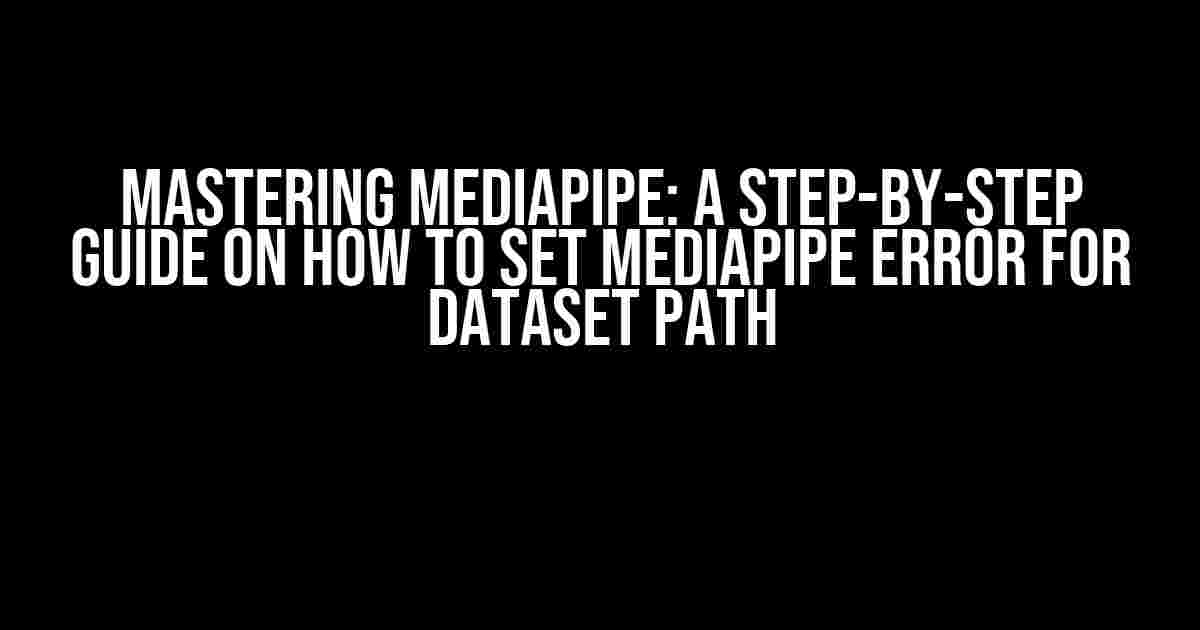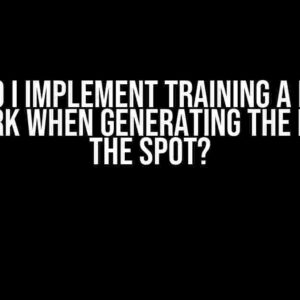MediaPipe, a powerful open-source framework developed by Google, has revolutionized the way developers build and deploy machine learning pipelines. One of the most critical components of any machine learning project is handling errors, and MediaPipe is no exception. In this comprehensive guide, we’ll delve into the world of MediaPipe and explore the intricacies of setting MediaPipe error for dataset path. Buckle up, folks, and let’s get started!
Understanding the Importance of Error Handling in MediaPipe
Before we dive into the nitty-gritty of setting MediaPipe error for dataset path, it’s essential to understand why error handling is crucial in MediaPipe. When working with large datasets, even the slightest mistake can lead to catastrophic consequences, such as data corruption, pipeline failure, or even worse, incorrect model deployment.
MediaPipe, being a data processing framework, is prone to errors when dealing with dataset paths. This is because dataset paths are often complex, containing multiple directories, subdirectories, and files. A single typo or incorrect configuration can lead to errors, making it essential to implement robust error handling mechanisms.
What is a MediaPipe Error for Dataset Path?
A MediaPipe error for dataset path occurs when the framework encounters an issue while processing a dataset. This can happen due to various reasons, such as:
- Invalid dataset path
- Missing dataset files
- Incorrect file format
- Permission issues
- Network connectivity problems
When a MediaPipe error occurs, the framework will raise an exception, halting the pipeline execution. This is where our guide comes in – to help you set up MediaPipe error handling for dataset paths and ensure your pipeline runs smoothly.
Step-by-Step Guide to Setting MediaPipe Error for Dataset Path
Now that we’ve covered the importance of error handling and the types of errors that can occur, let’s dive into the step-by-step process of setting MediaPipe error for dataset path.
Step 1: Install MediaPipe and Required Libraries
Before we begin, ensure you have MediaPipe installed along with the required libraries. You can install MediaPipe using pip:
pip install mediapipeStep 2: Import Required Modules and Initialize MediaPipe
In your Python script, import the required MediaPipe modules and initialize the framework:
import mediapipe as mp
import mediapipe.tasks.autoit as autoit
mpsolution = mp.Solution({
'type': 'media_pipe',
'task': 'data_processing'
})Step 3: Define the Dataset Path and Configuration
Next, define the dataset path and configuration. This includes specifying the dataset file format, path, and any additional settings:
dataset_path = '/path/to/dataset'
dataset_config = {
'file_format': 'csv',
'delimiter': ',',
'header_row': True
}
mpsolution.config['dataset'] = dataset_configStep 4: Create a MediaPipe Error Handler
Now, create a MediaPipe error handler function to catch and handle errors. This function will be responsible for raising exceptions and providing error messages:
def media_pipe_error_handler(error_code, error_message):
if error_code == 1:
raise ValueError('Invalid dataset path')
elif error_code == 2:
raise FileNotFoundError('Dataset file not found')
else:
raise Exception('Unknown error: {}'.format(error_message))
mpsolution.config['error_handler'] = media_pipe_error_handlerStep 5: Set Up Error Handling for Dataset Path
In this step, we’ll set up error handling for the dataset path. We’ll use the `try-except` block to catch any errors that occur while processing the dataset:
try:
mpsolution.process(dataset_path)
except Exception as e:
media_pipe_error_handler(1, str(e))MediaPipe Error Codes and Messages
When working with MediaPipe, it’s essential to understand the error codes and messages. This will help you identify and diagnose issues efficiently. Below is a table outlining common MediaPipe error codes and messages:
| Error Code | Error Message |
|---|---|
| 1 | Invalid dataset path |
| 2 | Dataset file not found |
| 3 | Permission denied |
| 4 | Network connectivity issue |
| 5 | File format not supported |
Best Practices for MediaPipe Error Handling
When working with MediaPipe, it’s crucial to follow best practices for error handling. Here are some tips to keep in mind:
- Use try-except blocks: Wrap your MediaPipe code in try-except blocks to catch and handle errors.
- Define custom error handlers: Create custom error handlers to provide informative error messages and codes.
- Log errors: Log errors to track issues and identify patterns.
- Test thoroughly: Test your MediaPipe pipeline thoroughly to catch errors early.
- Document error handling: Document your error handling mechanisms to ensure maintainability and scalability.
Conclusion
In this comprehensive guide, we’ve covered the importance of error handling in MediaPipe, how to set MediaPipe error for dataset path, and best practices for error handling. By following these steps and tips, you’ll be well on your way to building robust and error-free MediaPipe pipelines.
Remember, error handling is an essential aspect of any machine learning project, and MediaPipe is no exception. By mastering error handling in MediaPipe, you’ll be able to build more reliable and efficient pipelines, ultimately leading to better model performance and deployment.
Additional Resources
For further learning and exploration, we recommend checking out the following resources:
We hope this guide has been informative and helpful in your MediaPipe journey. Happy coding!
Frequently Asked Questions
Solve your MediaPipe dataset path woes with these expert-approved FAQs!
How do I set the dataset path for MediaPipe?
To set the dataset path for MediaPipe, you’ll need to specify the path to your dataset in the `calculator.proto` file. You can do this by adding the `dataset` field to your `CalculatorOptions` message. For example: `dataset: “path/to/your/dataset”`.
What if my dataset is stored in a separate folder?
No problem! If your dataset is stored in a separate folder, you can specify the relative path to the folder in the `dataset` field. For example, if your dataset is in a folder called `data` within your project directory, you can set `dataset: “data/”`.
Can I set multiple dataset paths for MediaPipe?
Yes, you can set multiple dataset paths for MediaPipe by using the `datasets` field instead of `dataset`. This field accepts a list of strings, so you can specify multiple paths separated by commas. For example: `datasets: [“path/to/dataset1”, “path/to/dataset2”]`.
How do I troubleshoot dataset path issues in MediaPipe?
If you’re experiencing issues with your dataset path in MediaPipe, try checking the following: Ensure that the path is correct and pointing to the correct location. Check for typos or extra slashes. Make sure the dataset is in the correct format and has the correct permissions. If none of these solutions work, try resetting the `calculator.proto` file or seeking help from the MediaPipe community.
Are there any best practices for organizing my dataset for MediaPipe?
Yes, here are some best practices for organizing your dataset for MediaPipe: Keep your dataset in a consistent format, such as CSV or JSON. Organize your data into logical folders and subfolders. Use clear and descriptive names for your files and folders. Avoid using special characters or spaces in your file names. By following these best practices, you’ll be able to easily manage and maintain your dataset for optimal performance with MediaPipe.



